(*1943)
Vladimír Havrilla


(*1943)
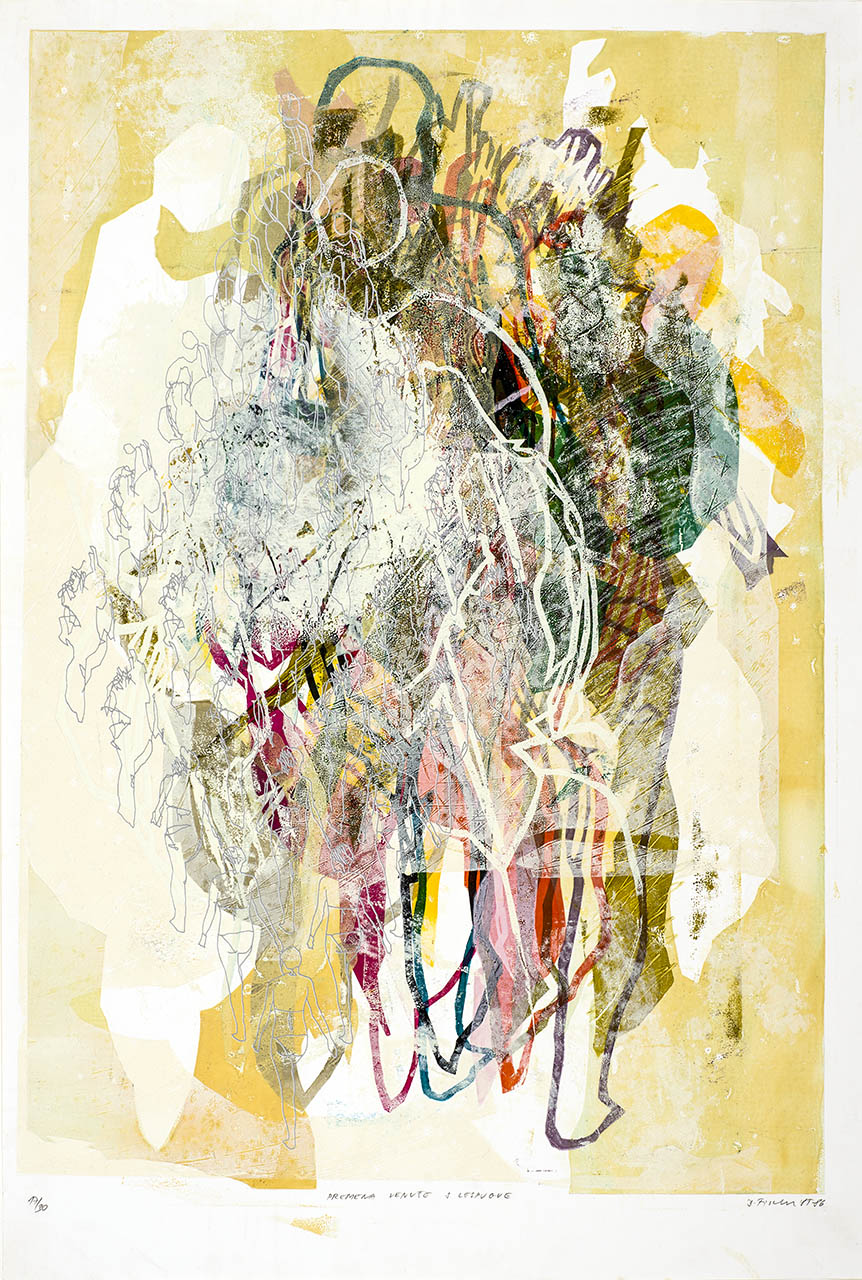
Daniel Fisher’s work occupies a unique place on the art scene thanks to his uncompromising interest in the presentation of a meaningful and authentic dialogue with the cognizable world and beyond. He focuses on the issues of consciousness and the need for its qualitative transformation on different levels.
Various transformations and levels of painting have been a part of his artistic program since he was a student. In his words, altruistic, aesthetical-ethical and trustful contact with the world and not just with a kind of concept of it represents the basis of his orientation. Art and its ability to uncover, clarify, and transcend these phenomena are another important part of this.
In the 1970s he was one of the first artists in the country to create computer graphic prints. He maintains a tension between the given and the accidental, the artificial and the natural, and the visual and the textual in an innovative manner. In the mid-1980s he developed his most extensive cycle entitled Maľby v krajine (Landscape Paintings) which he created outdoors. He subsequently objectivizes and documents his concentrated interest in nature as a source of inspiration and harmony in the form of photography at the moment when a painting “becomes part of the space which is beyond us”. The format itself plays the psychological role of a gate or portal, where Fisher presents the experience of intersecting and merging two entities into one. He also uncovers the metaphysical polarity of recognition and secret, concealment and uncovering, being and Existence.
His multimedia work with overlaps from painting, object, photography to multimedia installations has an outstanding timelessness and topicality. It concerns basic metaphysical questions as well as the traumas of our 20th and 21st century society. Mobile, light, spatial and illusive installations attract spectators by their visuality up to the moment when they look anew at disturbingly repeating history face-to-face.
The complexity, processuality, conceptual thoughtfulness, and technical virtuosity of Fischer’s works are evidence of the fact that contemporary visual art can still surprise us by its new positions and along with its aesthetic position keep a meaningful dialogue with its surroundings.
Since the 1970s, Daniel Fischer has been a distinctive figure whose artistic and pedagogical activities can impact the development of domestic visual culture. During the socialist era, he worked at an art school in Bratislava. In 1990 he became an associate professor of painting at the Academy of Fine Arts and Design, where he is co-author of the new concept and head of the studio of painting. In addition to many exhibitions at home and abroad, he presented his work at the Czecho-Slovak Pavilion at the XLV Biennale Venezia in 1993.

(*1941, Olomouc)
Immediately upon entering the visual art scene at the end of the 1960s, Jana Želibská boldly rejected the limits of usual media. Her new imagery of a “different” art disturbed the conventional world of ideas related to the traditional role of women. Her work grew from inspirations from the Pop Art environment and the action synthesis of art and life; in the 1970s she participated in creating collective festivities and individual performances. Later she used various technical devices such as video, photography and sound to develop her post-conceptual work, particularly in the area of installations and video-art. She explored themes close to feminist art such as carnality, erotica, the myth related to female beauty, and relations between men and women, to underline not only their spiritual and physical aspects, but also their natural, social and civilization dimensions. Ironic discourse is a characteristic feature of her work: she de-patheticizes the traditional assignment of the life and social roles of men and women and their related false myths and pseudo-romantic fictions.
She studied at the Academy of Fine Arts in Bratislava from 1959 to 1966 under Prof. P. Matejka. She was co-founder of the group Čenkovej deti (Čenková’s Children)(1989), whose name was later changed to Untitled (1994). The Slovak National Gallery featured her work in a monographic exhibition in 2012. She is also attracting increased attention on the international scene.
International exhibitions: VIII. Biennale de Paris, Musée d´Art Moderne de la Ville de Paris, Paris (1973); Aspekte / Positionen. 50 Jahre Kunst aus Mitteleuropa 1949 – 1999, Museum Moderner Kunst Stiftung Ludwig, Vienna (1999); Gender Check. Feminity and masculinity in the art of Eastern Europe, Museum der Moderner Kunst, Stiftung Ludwig, MUMOK, Vienna (2009); International Pop, Walker Art Center, Minneapolis (2015); The World Goes Pop, Tate Modern, London (2015) , and others.
Representation in collections: Slovak National Gallery, Bratislava; Bratislava City Gallery; regional galleries in the Slovak Republic and private collections, and others.
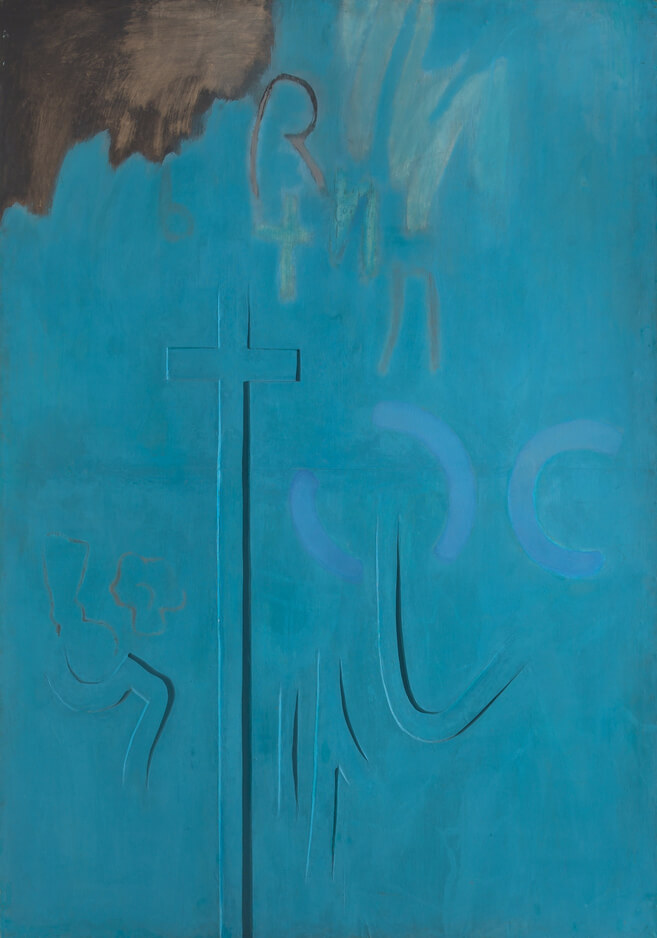
(*1946, Žilina)
One of the most significant figures of Czech and Slovak visual art from the beginning of the 1970s, Rudolf Sikora was also active on the unofficial – alternative art scene during the period of Normalization. He organized 1. otvorený atelier (The 1st Open Studio) (1970) in his studio in Bratislava which heralded the arrival of a strong generation of artists. He emerged from his own synthesis of the “new sensibility” and conceptual thinking and later enriched it with post-Modernist inspirations. He was one of the first artists in Czechoslovakia and Europe to deal with the theme of global-civilization and the ecological threat to the world. He based his own cosmological vision on scientific knowledge from the theory of the origin and existence of the universe while creating an original, artistic parallel to science. His ongoing social activism systematically reflects the legacy of Russian revolutionary avant-gardes represented in particular by the work of Malevich. He has made an impact in painting, drawing, printmaking, photography, action art, the creation of objects and installations. As one of the initiators of the Verejnosť proti násiliu (Public against Violence) movement (1989), he actively entered the world of politics for a short period of time. He was also co-founder of the group Syzýgia (1988).
He studied at the Academy of Fine Arts in Bratislava from 1963 to 1969 under Prof. P. Matejka and later taught there (1990 – 2004) before continuing his pedagogical work at the Faculty of Arts of the Technical University in Košice (2004 – 2011). He presented a retrospective of his work at the National Gallery in Prague in 2006 and at the Slovak National Gallery in Bratislava in 2008.
International exhibitions: Aktuelle Kunst aus Osteuropa, Oldenburger Kunstverein, Oldenburg (1982); Akademie 1993, Akademie der Künste, Berlin (1993); Europa, Europa, Kunst- und Ausstellungshalle der BRD, Bonn (1994); Der Riss im Raum, Martin-Gropius-Bau, Berlin (1994); Aspekte / Positionen. 50 Jahre Kunst aus Mitteleuropa 1949 – 1999, Museum moderner Kunst Stiftung Ludwig, Vienna (1999); Light Years: Conceptual Art and the Photograph 1964 – 1977, Art Institute, Chicago (2011) , and others.
Representation in collections: Art Institute of Chicago, Chicago; National Gallery of Art, Washington DC; Kupferstich Kabinett, Stadtsgalerie Dresden, Dresden; Photosammlung Museum Ludwig, Cologne ; Galerie der Stadt Esslingen, Museum Bochum, Bochum; Museum of Fine Arts, Houston; National Gallery in Prague; Slovak National Gallery, Bratislava, and others.

(*1966, Žilina)
(*1966, Žilina) One of the most distinctive representatives of post-conceptual tendencies, Roman Ondak has received the most international recognition from among Slovak artists. He works with surrounding reality – its poetic staging and contextual shifts. He likes to pull spectators into the game through constant, contradictory and unexpected shifts of meaning. He frequently varies visual perceptions. Through the use of different means and even disturbing activities, he established a new balance while employing the most diverse possible artistic forms and media: drawing, video recording, photography, performance, sculpture and installation. Nowadays, his work features “playful”, minimalist interior situations and interventions in an environment whose hints thematize disturbances and deviations in various cultural and social relations, interpersonal communication and living situations.
He studied at the Academy of Fine Arts in Bratislava from 1988 to 1994 under prof. D. Fischer and participated in internships and residential stays at Slippery Rock University, Pennsylvania (1993) and DAAD Berlin, where he was a scholarship recipient (2007 – 2008). He lives in Bratislava. He has presented his projects at monographic exhibitions at Kunstvereine, Cologne (2004); Tate Modern, London (2006), Pinakothek der Moderne, Munich (2007); MoMA, New York (2009); Musée d’Art Moderne de la Ville de Paris; Deutsche Guggenheim, Berlin (2012); Museo Reina Sofia, Madrid (2013), among others. He also participated at the Berlin Biennale (2010) and was featured in the main international exhibition at the Biennale in Venice (2003, 2011), where he also carried out an extremely successful project entitled LOOP for the Czech and Slovak Pavilion (2009), which earned him a nomination for the prestigious Hugo Boss Prize (2010).
International exhibitions: Manifesta 1, Rotterdam (1996); Aspekten – Positionen 1949 – 1999. Museum Moderner Kunst, Vienna; After the Wall. Moderna Musseet, Stockholm (1999); Manifesta 3., Ljubljana (2000); Promesses du Passée. Une histoire discontinue de l’art dans l’ex-Europe de l’Est. Centre Pompidou, Musée National d’Art Moderne, Paris (2010); dOCUMENTA(13). Kassel (2012); Une histoire, art, architecture et design, des années 80 à aujourd’hui Paris. Centre Pompidou, Musée National d’Art Moderne, Paris (od 2014) , and others.
Representation in collections: MoMA, New York; Guggenheim Museum, New York; Centre Pompidou, Musée National d’Art Moderne, Paris; Pinakothek der Moderne, Munich; Tate Modern, London; Slovak National Gallery, Bratislava;, Bratislava City Gallery; private collections abroad and at home, and others.
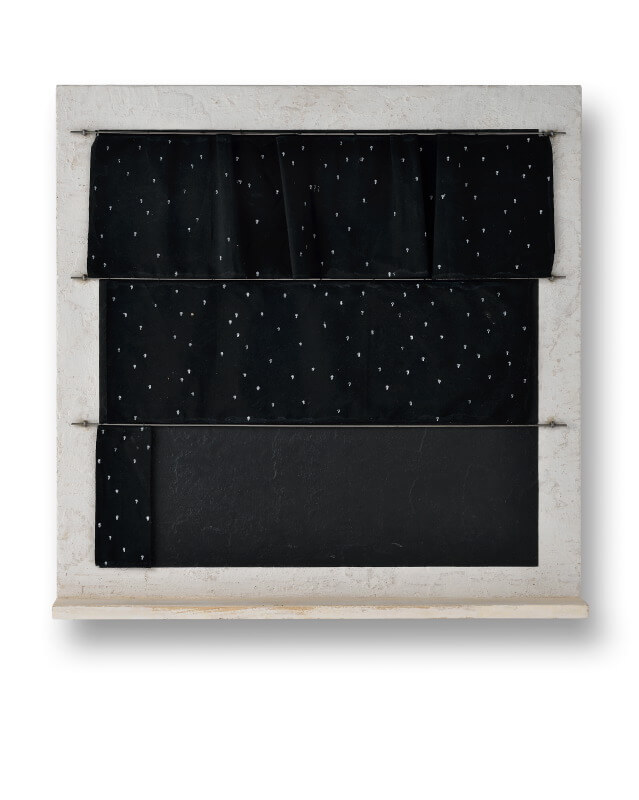
DEZIDER TÓTH | MONOGRAMISTA T.D. (*1947, Výčapy-Opatovce)
Entering the visual art scene at the beginning of the 1970s and during the times of Normalization, Dezider Tóth was one of the initiators and regular participants in unofficial fine art activities (he was the youngest participant in Sikora’s Otvorený atelier [Open Studio]). As a conceptual artist, he combined the inspirations of action art, land-art and visual poetry in an original way. He understood art as open communication and a game – and it became for him a synonym for creativity without boundaries, a way of understanding the surrounding reality, the means for spontaneous and thought out identification with the world and the creation of his new visual metaphor, which can be seen and discovered anywhere. He was particularly interested in expressing the ethical relationships of man and nature; the themes of wounding and protection from wounding and the protection of the environment of our lives as such were predominant in his work for a long period of time. He works with texts, words associated with poetic ideas more than terms of conceptual art or the art of ideas. He is active in the field of text art, visual scores, open air objects and actions; he has also documented his conceptual work in the medium of photography. Since 1991 he has mainly created installations; the most famous are his mural variations of shelves with manipulated books. He is a member of the group A-R (Avance-Retard, 1989), whose members have analytically surveyed classical media, or developed and commented on a specific visual form of concept since the end of the 1970s.
He studied at the Academy of Fine Arts in Bratislava from 1966 to 1972 under Prof. P. Matejka, where he today works as professor at the Department of Painting and Other Media. He also works in the area of book and graphic design. Since 1997 he has worked under the pseudonym Monogramista T.D.; he also publishes under the name Andro Verdan. In 2011, together with Boris Meluš and the OKO publishing house, he compiled and published Monogramista T.D. Nie som autor, som metafora.[ Monogramista T.D. I am Not an Author, I am a Metaphor]. He lives in Brno and Bratislava.
International exhibitions: Artists from Central and Eastern Europe, Mattress Gallery, Pittsburgh (1995); Body and the East. From the 1960 to the Present, Moderna Galerija, Lubljana (1998) , and others.
Representation in collections: Mattres Factory, Pittsburgh; Städtische Museen, Heilbronn; Pécsi galéria, Pécs; Ulmer Museum, Ulm; Art Museum, Olomouc; National Gallery in Prague; Slovak National Gallery, Bratislava; Bratislava City Gallery; regional galleries in the Slovak Republic and private collections, and others.
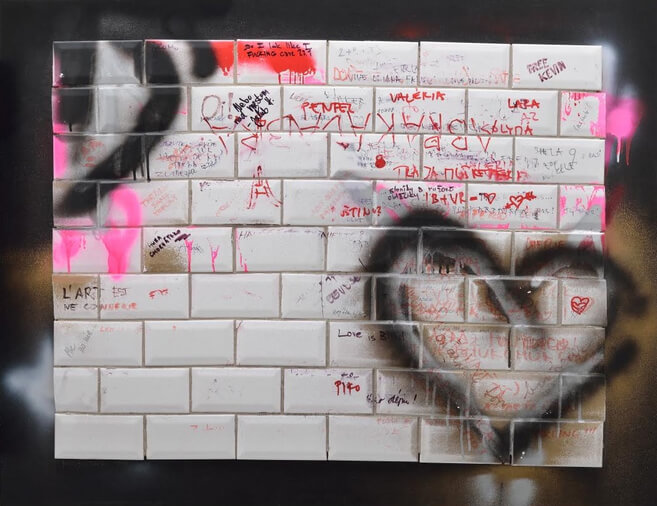
(*1934, Žilina)
entered the history of the Slovak Neo-Avant-Garde as a persistent seeker of a “different side of art.” He was the first Slovak artist to introduce the idea of the unity of artistic creativity and the creativity of an authentic life: he changed “art – work” to “art – act.” As the initiator of the total connection of art and life based on the appropriation of reality in the 1960s, he kept Slovak visual art in step with the most contemporary European trends. In the first half of the decade he was influenced by Informel; the essential part of his non-conformist work consists of festivities – “live games” – large scale, spontaneous holidays of collective creativity and perspective utopian projects. By applying planetary imagination as well as a sense of ironic playing with meaning, erotic mystification and poetic civilization fiction, he strives to dematerialize the essence of artwork.
At first he studied privately. In 1951, after attempting to illegally emigrate from Czechoslovakia, he was captured and imprisoned, but he went on to study at the Academy of Fine Arts in Bratislava from 1959 to 1965 under Prof. P. Matejka and at the Academy of Fine Arts in Prague from 1963 to 1964 under Prof. V. Sychra. He cooperated with the Parisian New Realists movement and with theoretician Pierre Restany and carried out “permanent manifestations” in Slovakia and France. In 1971, together with architects Viera Mecková and Ľudovít Kupkovič, he founded a group of prospective architecture entitled VAL (Cesty a aspekty zajtrajška [Paths and Aspects of Tomorrow]). Since 1992 he has been living in Paris and Žilina. He exhibited at the Paris Youth Biennale (1967, 1969, 1971), and independently at the Biennale in Venice (1972). The publication Inde (Somewhere Else), which featured a text by Pierre Restany (1994), was intended for the un-implemented exhibition at the Slovak National Gallery; a retrospective exhibition was held at the Bratislava City Gallery (2014).
International exhibitions: Europa – Europa, Kunst- und Ausstellungshalle der BRD, Bonn; Riss im Raum, Martin-Gropius-Bau, Berlin (1994); Aspekte / Positionen. 50 Jahre Kunst aus Mitteleuropa 1949 – 1999, Museum Moderner Kunst Stiftung Ludwig, Vienna; Global Conceptualism: Points of Origin 1950s – 1980s, Queens Museum of Art, Queens (1999); Sounding the Body Electric. Experiments in Art and Music in Eastern Europe 1957 – 1984, Muzeum Sztuki Lodz, Lodz (2012) , and others.
Representation in collections: Moderna galerija, Ljubljana; National Museum of Modern Art, Tokyo; National Gallery in Prague Prague; Art Museum, Olomouc; Slovak National Gallery, Bratislava; Bratislava City Gallery; Považie Art Gallery, Žilina, and others.
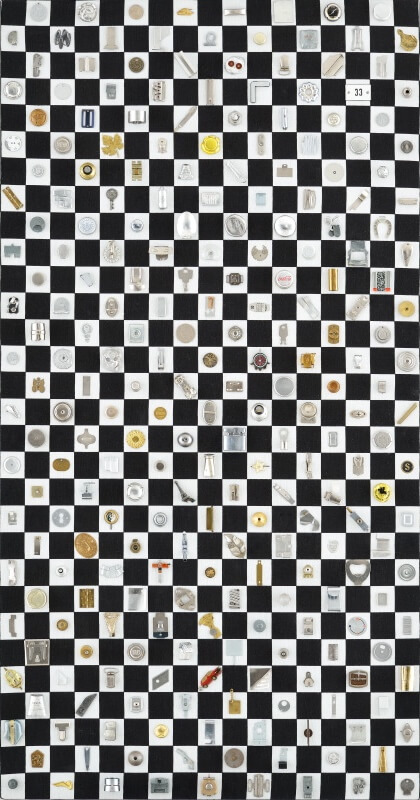
(*1946, Valaská)
“collector and hunter” and creator of collages, assemblages, objects and installations made of found items is one of the most original figures of contemporary Slovak art. For years he has systematically collected items – old things that “nobody misses.” He recycles them, collects them, combines them and puts them into sets from which he creates works of a new associative meaning and poetic figurativeness. Laubert’s work is not only a result of his lifelong passion for collecting, composing and creating subtle, precise collections made of the most common found items, and unnecessary and discarded things. It is particularly the outcome of his original interpretational act of seeing and “creation,” through which he shifts apparently banal and unusable fragments of reality to the world of art (not without the inspirations of Duchamp’s Dada gesture). The ephemerality of the world of things overlaps here with ceremonial solemnity, playfulness and brilliance with seriousness, and prose with poetry.
He studied at the School of Arts and Crafts in Bratislava from 1961 to 1965 and later worked at the workshops of the Slovak National Theater and in the exhibition sector. He called himself a “Sunday painter,” but in 1975 he became more systematic in his free time activities. He organized private exhibitions in his house for a limited number of friends, colleagues and people he knew. In 1978 he began to exhibit at unofficial events along with his friends – artists with whom he later created a group called A-R (Avance-Retard, 1989). In the late 1970s its members analytically surveyed classical media and developed and commented on a specific visual form of concept. After 1989, his exhibition activities abroad increased. In 1990 he started to cooperate with Vienna gallerist Hans Knoll. His first monographic exhibition was held at the Slovak National Gallery in 1992; however since then he has exhibited his work at several Slovak galleries. His monograph, which was published in 2000, was written by Jana Geržová. He lives and works in Bratislava, where in 2015 he established and opened his own Otis Laubert Museum.
International exhibitions: Metropolis, Martin-Gropius-Bau, Berlin (1991); Der Riss im Raum, Martin-Gropius-Bau, Berlin (1994); Artists from Central and Eastern Europe, Mattress Gallery, Pittsburgh (1995) , and others.
Representation in collections: Mattress Factory Pittsburgh; National Gallery in Prague; Art Museum, Olomuc; Slovak National Gallery, Bratislava; Bratislava City Gallery; regional galleries in the Slovak Republic and private collections abroad and at home, and others.
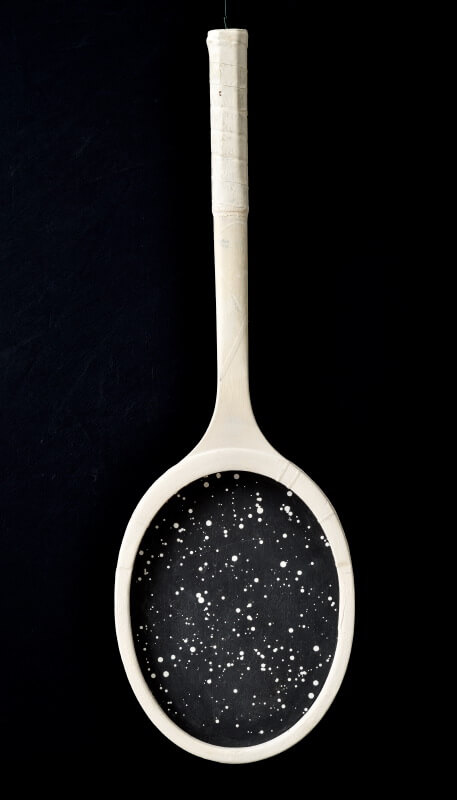
(*1939, Piešťany – †2007, Bratislava)
The pioneer of a “different” creativity, Július Koller was a painter, creator of events, projects and concepts through which he polemically commented on the social, civilization and cultural situation. Koller initiated a new pop-cultural version of artwork apprehension even before the mid-1960s while using absurd Neo-Dada poetics. By promoting various banalities in the framework of painting he managed to eliminate the border between “low” and “high” art and broaden the limits of artistic visuality, which he also enriched with his typical (dark) humor. He was interested in sports (fair-play in particular), extraterrestrials from UFOs, as well as environmental protection and last but not least, political events (August 1968) and their unfortunate consequences for society. Early on he began to work with signs and text, most frequently with punctuation marks; question marks became his emblem. He systematically avoided the term art. He viewed creation as a cultural process through which he intended to make a discreet yet persistent impact on his contemporaries. Starting in 1970, he designated all of his cultural operations (including the creation of conceptual Anti-pictures) as Universal- Cultural Futurological Operations (U.F.O). In the West, he is one of the best known representatives of the art of the former “Ostblock” in terms of exhibitions and reviews.
He studied painting at the Academy of Fine Arts in Bratislava from 1959 to 1965 under Prof. J. Želibský. A retrospective of his work was held at the Slovak National Gallery in 2010 and a large monographic exhibition is being prepared for MUMOK in Vienna for 2016.
International exhibitions: Face a l’histoire, Centre Pompidou, Paris (1997); Aspekte | Positionen. 50 Jahre Kunst aus Mitteleuropa 1949 – 1999, Museum moderner Kunst Stiftung Ludwig, Vienna (1999); Global Conceptualism: Points of Origin 1950s – 1980s, Queens Museum of Art, New York (1999); Utopia Station. 50. Espositione Internationale d’Arte, Biennale di Venezia, Venice (2003); Promesses du Passée.Une histoire discontinue de l’art dans l’ex-Europe de l’Est, Centre Pompidou, Musée National d’Art Moderne, Paris (2010); International Pop, Walker Art Center, Minneapolis (2015), and others.
Representation in collections: Centre Pompidou, Musée National d’Art Moderne, Paris; MoMA, New York; Tate Modern, London; Erste Bank Group Collection, Generali Foundation, Vienna; National Gallery in Prague; Slovak National Gallery, Bratislava, and others.
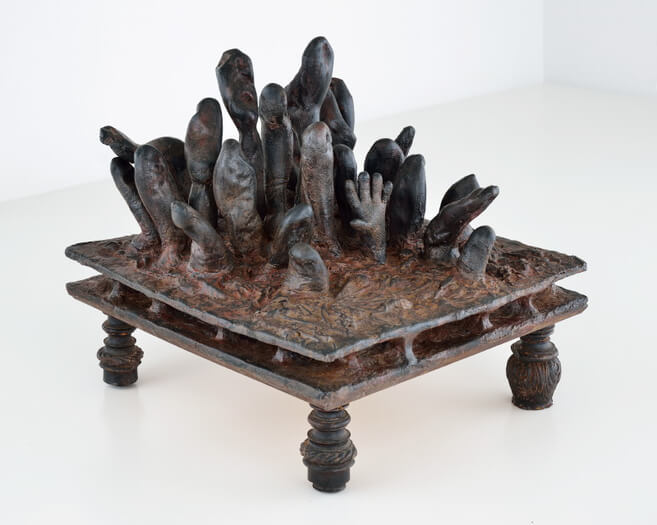
(*1937, Bratislava- † 2017, Bratislava)
The leading figure of modern Slovak sculpture, Jozef Jankovič’s brutal figural style, a result of his original synthesis of inspirations of Pop Art, New Figuration and New Realism, culminated in the second half of the 1960s in his extensive sculpture work which won broad international recognition. He presented the issue of human carnality in a derived, non-authentic and deformed form, and through a moral appeal he managed to metaphorically generalize the existential trauma of modern man and the current social and political contexts. During the times of Normalization he was excluded from fine art life; as a result, he actively participated on the unofficial scene, working with “small” forms: drawing, jewelry. He was also one of the first artists in Slovakia to systematically use computer graphics. In the 1980s he returned to large-size and chamber sculpture and reliefs. His lifework is a monumental parable of man, the drama of his individual and social fate, estrangement to himself and totalitarian power in its all possible forms.
He studied at the Academy of Fine Arts in Bratislava from 1956 to 1962 under Prof. J. Kostka. He began teaching there in 1990 where he served as rector (1990 – 1994) and professor (1994 – 2007). He twice exhibited at the Biennale in Venice (1972, 1995) and won several prestigious awards such as the Grand Prix of Danuvius Biennale in Bratislava (1968), the Biennale de Paris (1969), and the Herder Prize (1983). His work has been presented at several monographic exhibitions and a retrospective at the Slovak National Gallery (1997). He created monumental works in architecture and the environment. His group of sculptures entitled Obete varujú! (Victims are Warning!) for the Monument of the Slovak National Uprising in Banská Bystrica (1964 – 1965) was removed during the times of Normalization but restored in 2004. He also created sculptures in Croatia, Slovenia, Germany, France (Paris) and South Korea (Seoul).
International exhibitions: Europa – Europa, Kunst- und Ausstellungshalle der BRD, Bonn; Riss im Raum, Martin-Gropius-Bau, Berlin (1994); Aspekte / Positionen. 50 Jahre Kunst aus Mitteleuropa 1949 – 1999, Museum Moderner Kunst Stiftung Ludwig, Vienna; Global Conceptualism: Points of Origin 1950s – 1980s, Queens Museum of Art, Queens (1999); The World Goes Pop, Tate Modern, London (2015) , and others.
Representation in collections: E.P.A.D la Défense, Paris; Albertina, Vienna; Museum des XX. Jahrhunderts, Museum moderner Kunst Stiftung Ludwig, Vienna; Centrum rzeźby polskiej, Oronsko; National Museum of Contemporary Art, Soul; National Gallery in Prague; Slovak National Gallery, Bratislava, and others.
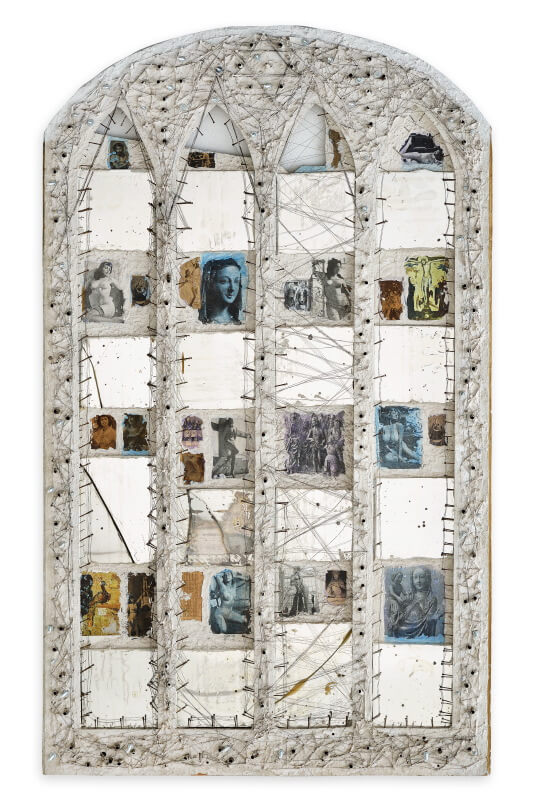
(*1937, Veľká Hradná – † 2015, Bratislava)
From the second half of the 1960s up to the present, Stano Filko is perhaps the most universal and radical artist of the Slovak visual art scene; he is also known as a “professional avant-gardist.” In the course of almost five decades, he has made an impact in almost all of the important development tendencies in contemporary visual art, while using virtually all of the classical and new visual media: art of object, environment, happening and action, new painting and multimedia installation. His work combines several philosophically justified positions arising from each other based on rudimentary conceptual thinking and supported by a strongly developed individual mythology. Filko gradually segmented his work based on a triad system of a synchronic nature. He projected and defined his lifelong creative orientation – “ego” – in a system (constantly perfected in the form of a fictitious “outside” historical scrummage), the basis of which was created by a combination of three simultaneous creative paths: the empirical (biological) symbolized by the color red (the 3rd dimension), the cosmological symbolized by the color blue (the 4thdimension), and the course of transcendence or ontology symbolized by the color white (the 5th dimension). He was one of the first artists in the 80s who in terms of gesture and color employed wild formative instruments in his work.
He studied at the Academy of Fine Arts in Bratislava from 1959 to 1965 under Prof. P. Matejka. In 1981, he emigrated from Czechoslovakia, and worked and lived in Germany and the USA (1983 – 1990). He returned to Slovakia after 1990. He exhibited in the Czecho-Slovak exposition at the Biennale in Venice (2005), and the Slovak National Gallery is preparing an exhibition of his work at the Zachęta National Art Gallery in Warsaw (2015).
International exhibitions: Cinétisme. Spectacle. Environnement, Maison de la culture, Grenoble (1968); Sixième biennale de Paris, Musée d´Art Moderne de la Ville de Paris, Paris; Environnement lumino-cinétique, Le Place de Châtelet, Centre National d´Art Contemporain, Paris (1969); Documenta 7, Kassel (1982); Aspekte /Positionen. 50 Jahre Kunst aus Mitteleuropa 1949 – 1999, Museum moderner Kunst Stiftung Ludwig, Vienna (1999); Living Art on the Edge of Europe, Kröller-Müller Museum, Otterlo (2006); Une Terrible Beauté Est Née / Biennale de Lyon, Musée d´art contemporain Foundation Bullukian (2011), and others.
Representation in collections: The Solomon Guggenheim Museum of Modern Art, New York; Brooklyn Museum, New York; Niagara Museum University, Niagara, N.Y.; Folkwang Museum Essen, Essen; Wilhelm Lehmbruck Museum, Duisburg; Erste Bank Group Collection, Vienna; National Gallery in Prague; Slovak National Gallery, Bratislava, and others.

(*1938, Praha)
(*1938, Praha) Along with Július Koller, Peter Bartoš is one of the first protagonists of the art of concept and action in Slovakia. His work is extremely difficult to grasp, but he is among the most original figures of the Slovak concept. Because of the fact that his relationship to the category of artistic original (even his own) was negative, many of his early works did not survive; he himself systematically gave them out, destroyed them, reworked them or disseminated them in the form of Xerox copies. He blurred the authorship by secondary interventions over a significant period of time and “diffused” them, frequently in cooperation with other artists, as if he were “trans” historically wandering through his own work (as a result, some of the works have more recent dates). Active and practical ecological landscaping (he found a job at the Bratislava ZOO) was another important side of his activities. He also worked with a “living medium,” so called animal-art. In the 1960s he bred carrier pigeons according to a pre-arranged project. This is how he created the Bratislava exhibition pigeon and the Bratislava aesthetic pigeon. His interest in ecology also found its reflection in a series of landscape projects, drawings and photo-concepts such as the inter-urban ZOO landscape, a hill for the breeding of Hucul ponies, and others. He designed, composed and created landscape thoughtfully as if it were a painting. He started out as a painter; as an advocate of a “situation concept” or a “concept of situation” he gradually reduced the structural elements of painting to a “zero situation” by eliminating any references to reality. He reached a new beginning, a “primary touch”, a “primary origin” of matter while combining the creation of a painting with performance. Bartoš later abandoned picture, but not painting. He carried it out in different media – through nature, snow, etc. He was searching for analogies among material structures of nature and painting; he claims that part of his work is a permanent “defense of painting,” which according to him is “eternal.” His drawings, concepts and plans later became the material for their systemized integration into a visual medium.
He studied at the Academy of Fine Arts in Bratislava from 1957 to 1965 under Prof. J. Želibský, and J. Mudroch), and completed his graduate studies from 1966 to 1967 under Prof. P. Matejka. He monographically exhibited his concepts at the Vienna Art Nouveau (2014).
International exhibitions: Body and the East. From the 1960 to the Present, Moderna Galerija, Ljubljana (1998); Global Conceptualism: Points of Origin. 1950’s – 1980’s, Queens Museum of Art, New York (1999) , and others.
Representation in collections: Slovak National Gallery, Bratislava; Bratislava City Gallery; Nitra Gallery, and others.
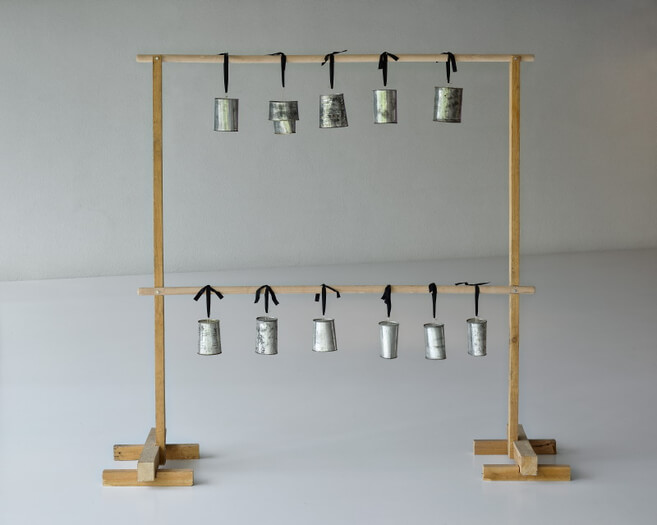
(*1946, Ružomberok – †2017, Žiar nad Hronom)
was one of the significant figures of intermedia art and his collected work resonates in a wider context of Central Europe. He worked with conceptual and action art, created visual poetry, graphic scores and unconventional sound objects; he was also an unorthodox musician, composer and musicologist, as well as an organizer of musical events and happenings. He developed his experimental program gradually in several separate lines of the New Music. From the 1960s he openly combined the elements of scientific research and active artistic activities, which spanned various artistic, poetic and musical types and genres. He studied viola at the Conservatory in Žilina (1962 – 1968), and musicology at the Faculty of Arts of Comenius University (1968 – 1973), he worked as musicologist at the Institute of Art History of the Slovak Academy of Sciences (1972 – 1991) where he studied music semiotics. He also lectured at several universities. In 1974, he was awarded a German scholarship from the town of Darmstadt and the DAAD Foundation to participate in New Music courses. He entered the scene approximately in the middle of the 1960s when he began to participate in collective projects and happenings (along with Robert Cyprich, Alex Mlynárčik, Július Koller and others). He began to create again more thoroughly from the 1990s – he founded the Transmusic Comp. ensemble (1989), and together with Peter Machajdík and Michal Murín he also founded the Spoločnosť pre nekonvenčnú hudbu SNEH (Society for Unconventional Music, 1990); he also organized Festival intermediálnej tvorby (Intermedia Creation Festival) in Bratislava (1991, 1992); he contributed to the invitation of John Cage to Slovakia and was the curator of his exhibition featuring Cage’s personal participation (1992, SNG). After 2010 he lived in the village of Banská Belá near Banská Štiavnica. In recent decades, Adamčiak’s work has become the subject of international interest and has won recognition and inspired many young artrists. His work was documented in a four-volume entitled Archív I. – IV.(Archive I -IV) by Michal Murín. The first retrospective exhibition entitled Adamčiak, začni! (Adamčiak, Begin!) was held at the Slovak National Gallery in Bratislava two months after his death (2017). International exhibitions and festivals: Between Concept and Action, Sonia Rosso Gallery, Turin (2009); European Culture Congress, Wroclaw (2011); NIPAF 10, The 17th Nippon International Performance Art Festival, Tokyo, Osaka, Nagano (2010, 2011); Truth is Concrete festival, Graz (2012) etc. Representation in collections: Avantgarde Museum – Marinko Sudac Collection, Zagreb; Galéria mesta Bratislavy, Bratislava; Slovenská národná galéria, Bratislava; private collections at home and abroad, etc.

(*1933, Kamenín)
developed the baselines of geometrical abstraction in the 1960s at the time of his inclination toward Concretism and Minimalism. He was also one of the first protagonists of action and concept. Rational approaches culminated in his work in the early 1970s when he was one of the first on the Slovak art scene to use a computer in the process of creating artwork. Another shift towards the dematerialization of the act of art was Bartusz’s work of the 1980s, when he absolutized the explosive gesture of the artist on a conceptual base. He is an artist of a dynamic creative range who continually searches for new identities: his rationally economical and emotionally spontaneous sculpture, painting and bodily creations were replaced by a new interest in performance, installation art and video-art. He studied at the Academy of Arts, Architecture and Design in Prague (1954 – 1958, under prof. J. Wagner, J. Kavan), before attending the Academy of Fine Arts (1958 – 1961, under prof. K. Pokorný, K. Hladík). In 1962 he moved to Košice, where he worked with monumental and chamber sculpture, action and land-art creation, as well as painting, installation, video and performance. He was a member of Klub konkretistov (Concretists’ Club, 1967 – 1971, after 1991). He also served as professor at the Academy of Fine Arts in Bratislava as the head of the Free Creativity Studio (1990 – 1999) and at the Department of Fine Arts and Intermedia at the Faculty of Arts of the Technical University in Košice (since 1999), whose establishment he initiated. He won several awards and prizes, including the Munkáczy Prize (2004). He was one of the cofounders of the International Sculpture Symposium in Metal in Košice (1967); his work entitled Súhvezdie Veľkého voza (Great Bear Constellation, 1968) installed in a park in Košice was officially removed in 1978. He implemented several architecturally and environmentally-related works, the land-art event Svetelná slávnosť I. (Festival of Lights I, 1974, in cooperation with G. Kladek). He had several solo and collective exhibitions at home and abroad, and his retrospective exhibition entitled Gestá/body/sekundy (Gestures/Points/Seconds) was held at the Slovak National Gallery in Bratislava (2010). International exhibitions: Sculpture Tchécoslovaque de Myslbek à nos jours, Musée Rodin, Paris (1968); Proyectos no realizados, Escuela Nacional de Artes Plasticas, Centro international dela cultura, Mexico (1981); Messiások – a modern művészet remekei a megváltásról. MODEM, Centre for Modern and Contemporary Arts, Debrecen (2009) etc. Representation in collections: Albertina, Vienna; Galerie der Stadt Esslingen, Esslingen; Národní galerie v Praze, Prague; Pécsi galéria, Pécs, Slovenská národná galéria, Bratislava; Szépművészeti múzeum, Budapest; Východoslovenská galéria, Košice etc.
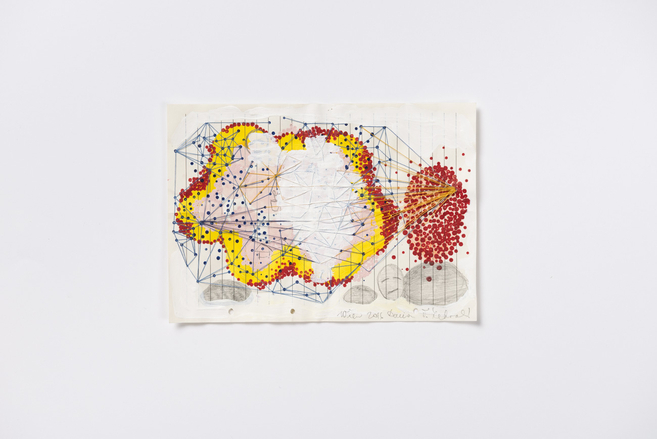
(*1971, Trenčín)
is part of the post-conceptual generation that emerged in the 1990s and is frequently associated with the feministic branch of contemporary art. She is an exceptional and internationally established artist of a concentrated but more intense vision based on the associative and time-intuitive principle of deliberation. She bases her work on non-figurative expression, as the forms of her sculptures at times refer to biomorphic and at other times to post-minimalist lineage. She works with the most internal ideas – intimacy, feelings (predominantly of women, mothers). Her work has the character of a diary entry, whether she draws or paints or works with found objects or sculptural forms and she prefers spatial artifacts. She always reacts to the given space for which she creates a “spatial collage”, as she calls her technique, when in an associative manner she links various media forms – created works, drawings, sculptures, objects, painting as well as found natural objects, stones, branches. She can be characterized by the serial nature of her deliberation (her works are usually untitled), as well as the touchable and palpable nature and precision of processing; she frequently works with completeness and variability, closeness and openness, stability and instability of form and its development in the creative process. She studied at the Academy of Fine Arts in Bratislava (1990 – 1996, under prof. R. Sikora). In 2012, the Slovak National Gallery in Bratislava held her monographic exhibition. Selected international exhibitions: Manifesta 3. Ljubljana (2000); Anxiety of Influence: Bachelors, Brides and a Family Romance. Stadtgalerie, Kunsthaus, Bern (2004); Raumkörper. Kunsthalle Basel; Micro-narratives. Musée d’Art Moderne, Saint-Etienne (2008); Gender Check: Femininity and Masculinity in the Art of Eastern Europe. Museum moderner Kunst Stiftung Ludwig, Vienna (2009); Report on the Construction of a Spaceship Module. New Museum, New York (2014). Representation in collections: Fiorucci Art Trust, Monaco; Sammlung Friedrichshof, Vienna; Société Générale, Paris; the Erste Bank Group Collection, Vienna; the Slovak National Gallery, Bratislava; regional galleries and private collections in Slovakia and abroad.

(*1963, Dunajská Streda)
is one of the most respected representatives of contemporary visual art at home and abroad; she is interested in gender and social topics, and moving the boundary between the public and the private. She is active in institutional criticism and social and political activism related to the environment of Hungarian and Slovak culture. Her early years were marked by Postmodern poetics before she moved to more objective and radical forms of found objects and installation, and their wider contextual defining. She was moving towards more grandiose and striking sets and targeted impacts on the environment. She later left behind the issues of aesthetics and concentrated on the address-orientation and utterance of her works through which she examines diverse topical social problems such as the Eastern Sugar project in Kunsthalle, Bratislava, 2018). Several of her daring furniture “sculptures” and installations are considered “icons of feminism” of the 1990s. These days she primarily works with object, installation, video and art in public spaces. She studied typography and book art at the Academy of Applied Arts in Budapest (1981 – 1986), where in 2006 she finished her postgraduate doctoral studies. She is co-founder and co-organizer of the activities of STUDIA erté (1987 – 1997, the Transart Communication festival of multimedia art in Nové Zámky). After graduating from the Academy, she began to work on both the Hungarian and Slovak visual art scenes. She has led the IN studio at the Department of Intermedia and Multimedia at the Academy of Fine Arts and Design in Bratislava since 2004. She won the award of the S. Márai Foundation (1998), the Munkácz Award (2001) and others. She represented Slovakia at the 49th Venice Biennale (2001, along with J. Surůvka). She lives and works in Dunajská Streda. Selected international exhibitions: After the Wall. Art and Culture in Post-Communist Europe. Moderna Museet, Stocholm; Aspekte/Positionen. 50 Jahre Kunst aus Mitteleuropa 1949 – 1999. Museum moderner Kunst Stiftung Ludwig, Vienna (1999); Gender Check: Femininity and Masculinity in the Art of Eastern Europe. Museum moderner Kunst Stiftung Ludwig, Vienna (2009); A hős, a hősnő és a szerző/ The Hero, the Heroine and the Author. Kortárs Művészeti Múzeum – Ludwig Múzeum/Museum of Contemporary Art – Ludwig Múzeum, Budapest (2012). Representation in collections: Győri Városi Múzeum, Győr; Kortárs Művészeti Múzeum – Ludwig Múzeum, Budapest; New Bedford Whaling Museum, New Bedford; Slovak National Gallery, Bratislava; Art Gallery of Považie Region in Žilina.

(*1942, Nové Zámky – †2016, Skalica)
was an artist with an urgent ethical challenge and a peculiar – anti-conventional – sculptural vision. He created environments and objects and became one of the most distinctive and original Slovak sculptors. In the late 1960s and early 1970s he introduced a new anti-aesthetic, “plebeian” view of sculpture. He reflected the relation of the then topical concept and Neo-Dadaistic object in an unorthodox and innovative way. This became the medium for him to express his uncompromising social and moral standpoints related to ecology and the freedom of the individual in society. During the period of Normalization when his exhibiting options were limited, he worked with visual poetry, and created graphic albums with “sculpture notes” and unimplemented sculptures which he distributed among his friends. As a master of the absurd visual and text metaphor, he commented on life around him and the topics of “grand” art, and through bittersweet feelings he revealed feelings of tragedy and civilization skepticism. The striking message of the work was always more important for Meliš than its smooth aesthetic form, and the final installations from the 1990s, charged with energy and roughly swift in their expression and ironic-sarcastic impact, are proof of that. He frequently worked with texts he created from simple materials and everyday objects. He created environments, objects, drawings, prints and collages. In his original artistic phase he implemented several works in architecture. He studied at the Academy of Fine Arts in Bratislava (1960 – 1966, under prof. J. Kostka) where he also worked as professor (from 1992) and head of the studio at the Department of Sculpture (1990 – 2008); he was also a part-time teacher at the Academy of Performing Arts in Bratislava (1973 – 1988). The retrospective of his work entitled Kovadlina snov (Anvil of Dreams) was prepared by the Slovak National Gallery in Bratislava (2002). Selected international exhibitions: Aktuelle Kunst aus Osteuropa. Oldenburger Kunstverein, Oldenburg (1982); Global Conceptualism: Points of Origin 1950s – 1980s. Queens Museum of Art, New York (1999) etc. Representation in collections: Kassák Múzeum, Budapest; Národní galerie v Praze, Prague; Galéria mesta Bratislavy, Bratislava; Slovak National Gallery, Bratislava; Linea Collection, Bratislava.
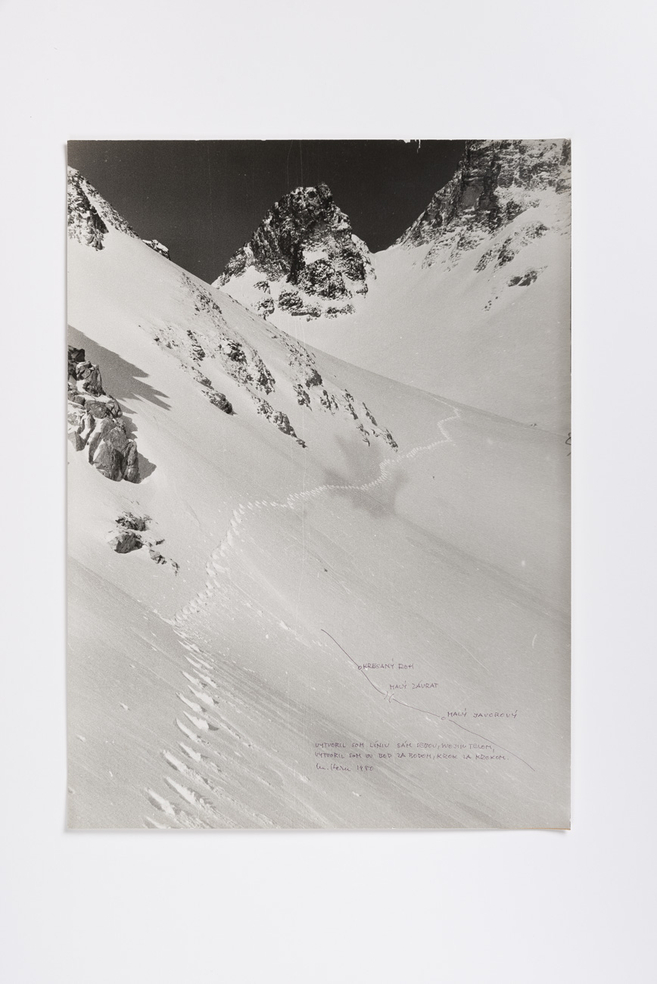
(*1938, Močiare pri Liptovskom Mikuláši – †1994, Močiare pri Liptovskom Mikuláši)
was one of the central figures of the unofficial art scene of the 1970s and 1980s. His conceptual and land-art thinking focused on nature, based on which he successfully built a convincing although discreet body of work in terms of media (photographs, drawings), in which he laid the main emphasis on thematizing the relations of man and nature, their mutual intertwining up to spiritual merging. He lived and worked at Močiare by Liptovský Mikuláš, in the family seat of his father, the painter Peter Július Kern. Fascinated by the cycles of nature and the majesty and fragility of the landscape and natural framework in which he lived, he understood his work as a silent and ardent dialogue with nature, a ritual process of mutual reflection, leaving traces, touching and penetrating; his “studio was nature and nature was his studio”. He frequently intervened in his landscapes with objects and his own body, where he left an extensive plastic trace. He worked with the principles of accident, appropriation, mirroring and “transient media”, snow, water, light. He studied at the Academy of Fine Arts in Bratislava (1956 – 1962, under prof. L. Čemický, J. Mudroch). Retrospective exhibitions were held at the Art Gallery of the Považie Region in Žilina (1996) and at the Bratislava City Gallery (2011). Selected international exhibitions: Naturally: Nature & Art in Central Europe. Ernst Múzeum, Budapest (1994); Between Concept and Action. Galleria Sonio Rosso, Torino, etc. Representation in collections: Moravská galerie v Brně, Brno; Muzeum Narodowe, Vroclav; Muzeum Sztuki, Lodz; Museum of Modern Art, Texas; Bratislava City Gallery, Bratislava; Slovak National Gallery, Bratislava; regional galleries and private collections in Slovakia and abroad.
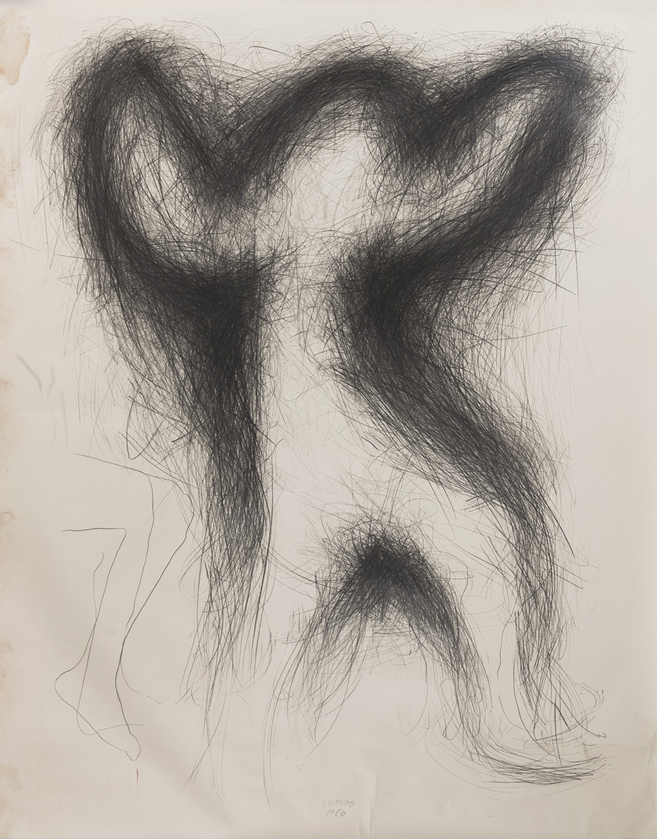
(*1957, Trenčín – †1987, Bratislava)
was a special representative of the unofficial fine art scene of the 1970s and the 1980s. Although he ended his life voluntarily (he lived to the age of thirty), he left behind a distinctive and coherent work which became his suggestive symbol of the period of unfreedom. His work developed within the inspirational neighborhood of the works of representatives from the future Avance-Retard/A-R group (M. Bočkay, L. Čarný, D. Fischer, V. Kordoš, O. Laubert, D. Tóth, etc.). He graduated from the Secondary School of Graphic Art in Bratislava, but due to ideological reasons (after 1968, his father, the journalist Slavo Kalný, was persecuted for his political standpoints), he could not study at the fine art academy. He based his work on conceptual art and minimal-art, and worked with text, word, and stamps, from which he created cycles of subtle and lyrical drawings – visual poems. He examined the possibilities of drawing, and by copying realistic objects he reached the active use of his body and its parts. This resulted in the creation of the final suggestive cycle of monumental drawings – body drawings. In his lifetime he exhibited in unofficial and rented premises, private apartments and elsewhere. He participated in Majstrovstvá Bratislavy v posune artefaktu / The Championship of Bratislava in the Shift of Artifact founded by Dezider Tóth (1979 – 1986), and cooperated with publishers of samizdats which he illustrated (Animal Farm by George Orwell). After 1989, his work was monographically processed and exhibited at numerous solo and collective exhibitions. The Igor Kalný Award, which is presented every three years to a young Slovak artists at the Zlín Salon of Young Artists, was established in 2006. Representation in collections: Národní galerie v Praze, Prague; Slovak National Gallery, Bratislava; Bratislava City Gallery, regional galleries and private collections in Slovakia.

(*1920, Zvolen)
concentrated on studying and recording the correlation of acoustic and visual relations from the middle of the 1960s. While drawing with a wooden stick, he realized the “acoustic event” in the rhythm of his drawing and the audio-spatial dimension of artwork, which opened a wide range of creative opportunities for him. He used unconventional items such as wooden sticks, a comb for harvesting blueberries, small boxes, glasses and bells to implement acoustic paintings and drawings before moving on to various self-propulsion mechanical items, such as nuts, cog-wheels, mechanical toy hens and frogs, etc. Thus, the acoustic drawings developed into a polyphony where the seen was liberated from the sound. This desired accident also entered the game along with the control when implementing the happening, and the artist was transformed into performer and spectator at the same time. He recorded his implementations on tapes and video. In the late 1960s he created tactile drawings along with these living drawings, where through the performative character of the happening he developed a kinetic drawing of the body without visual control over the artwork. He later developed various types of scores where he depicted sound by disturbing the structure, color, rhythm or a certain artistic element on the principle of its possible transfer to the acoustic level. In the 1990s he again concentrated on painting and excessive cycles of black paintings and Antiphons were created. The monochromatic black space is disturbed by a sharp color line which is a conductor of light and in a way replaces sound. New spatial bonds and happenings occur in Antiphons through the monochromatic effect of colorful visual areas. Milan Grygar studied at the Academy of Arts, Architecture and Design in Prague in the studio of monumental painting under prof. Josef Novák and Emil Filla (1945 – 1950). the retrospective exhibition of his oeuvre took place at the Prague City Gallery in 2014.
International exhibitions: Concrete poetry? Sound texts. Visual texts. Amsterdam, Stedelijk Museum; Stuttgart (1971); The 11th International Biennial Exhibition of Prints, Tokyo, The National Museum of Fine Art; Osaka (1979); Musique-Arts, Plastique; Intersections. Grenoble, Maison de la Culture (1981); Dessins tchèques du 20e siècle, Musée national ďArt moderne. Centre Georges Pompidou, Paris (1983); European Art Trends of 1960s –1980s. Warsaw, Muzeum Narodowe (1988); Beyond Geometry. Experiments in Form, 1940s-70s. Los Angeles, Los Angeles county Museum of Art; Miami, Miami Art Museum (2004); Art in Europe 1945 – 1968, ZKM, Karlsruhe (2016), and others.
Representation in collections: Centre Georges Pompidou, Paris; Stedelijk Museum, Amsterdam; Nationalgalerie, Berlin; Los Angeles County Museum of Art, Los Angeles; The National Museum of Art, Osaka; National Gallery of Art, Washington; Muzeum Sztuki w Łodži, Lodz; Národní galerie v Praze, Prague; Galerie hlavního města Prahy, Prague; Slovenská národná galéria, Bratislava, and others.
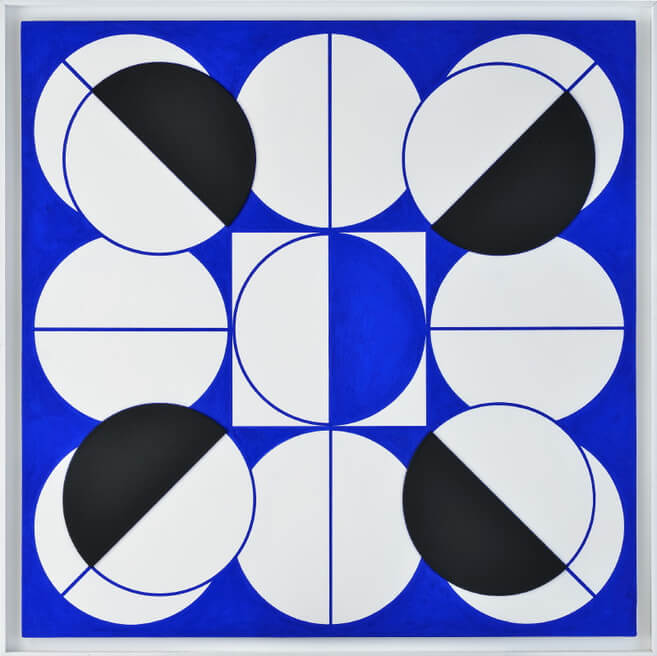
(*1929, Přerov)
is an internationally acknowledged kinetic artist who continues to develop the program of dynamic constructivism (this is how it was named and formulated by the artist himself in 1988) in Slovakia based on the synthesis of form, light and motion. He was the first to introduce the issues of optic and visual – kinetic art to the Slovak art community. In the first half of the 1960s, along with other artists around the world, he began to explore the rationally impersonal language of object: from op-art easels (based on playing with optical illusion on the surface) he moved on to three-dimensional light-kinetic work. Through his ingenious use of the phenomena of reflection, reflexes and light refraction, fictitious – illusive and real motion, transparency and color intensity of surfaces and three-dimensional forms he promoted his objects to open luminodynamic and spatial structures and poetic metaphors of our technological era. He has implemented his works in the U.S., Japan, Argentina, Uruguay, Germany and in Slovakia. During his trip to North America and South America he implemented a light-kinetic program for the American Wind Symphony Orchestra (1971). He studied painting at the Academy of Fine Arts in Bratislava (1951 – 1956 under professors Ladislav Čemický and Dezider Milly). His complete works were exhibited at the Slovak National Gallery in 1995. He lives in Bratislava, where the private Milan Dobeš Museum was founded in 2001, and where his works and the works of similar constructivist artists are on display. Among other publications, Dobeš’s works are mentioned Frank Popper’s Origins and Development of Kinetic Art (London, 1968), and in one of the most significant overviews of new “media” sculpture, Udo Kultermann’s The New Sculpture / Environments and Assemblages (London, 1968). Selected international exhibitions: Kunst-Licht-Kunst,Stedelijk van Abbemuseum, Eindhoven (1966), Konstruktive Tendenzen, Altstadtmuseum Fembohause, Nuremberg; Cinétisme. Spectacle. Environnement, Maison de la culture, Grenoble (1968); Documenta 4., Kassel (1968), X. bienal de São Paulo; ARS ´69, Ateneumin Taidemuseo, Helsinki; Tampereen Taidemuseo, Tampere (1969), EXPO ´70, Osaka (1970); Dynamo. Un siècle de lumière et de movement dans l´art. 1913 – 2013, Galeries Nationales du Grand Palais, Paris (2013.) etc. Representation in collections: Hudson River Museum, New York; Museo de Arte Moderno de Buenos Aires, Buenos Aires; Museum Folkwang, Essen; Múzeum Milana Dobeša, Bratislava; Národní galerie v Praze, Prague; Slovenská národná galéria Bratislava, Galéria mesta Bratislavy, Bratislava; Galéria Nedbalka, Bratislava; Galerie Benedikta Rejta, Louny.

(*1936, Praha – †1996, Košice)
is one of the most significant female artists from Slovakia and her work has found international recognition. Since the 1960s she worked with abstract sculpture, inclining toward biomorphic morphology, and for a short period of time toward Concretism in which she brought associativity and imagination. Although her work was close to organic sculpture, she went beyond this approach by emphasizing the metaphysical values of forming a mass. Plaster was the characteristic material which determined the fragile expression and “transient” and temporary nature of her sculpture. She developed several new techniques and methods of casting plaster sculptures of imprints, enclosed ovoid forms and open perforated shells. She reached her peak in the final artistic period in the 1980s when she created grandiose plaster installations; she formed extensive plaster plates, and imprinted draperies which receded under the pressure of embedded rocks and their sharp edges until progressing illness brought an end to her work. She studied at the Academy of Applied Arts in Prague (1951 – 1955, under prof. V. Šimek) and then at the Academy of Arts, Architecture and Design in the Department of Ceramics and Porcelain (1955 – 1961, under prof. O. Eckert). In 1963 she moved to Košice with her husband, sculptor Juraj Bartusz, where she created chamber and exterior sculptures and addressed the issues of haptic aesthetics which was unique in our country (1976, 1983, in cooperation with G. Kladek). Her work received broad international recognition only after her death. Her works were included in prestigious international exhibitions. The Slovak National Gallery in Bratislava prepared a retrospective of her work (2005), and the Museum of Modern Art/Muzeum sztuki Nowoczesnej in Warsaw (2014 – 2015) organized her monographic exhibition entitled Formy przejściowe/Provisional Forms. Selected international exhibitions: Documenta 12, Kassel (2007); Gender Check: Femininity and Masculinity in the Art of Eastern Europe. Museum moderner Kunst Stiftung Ludwig, Vienna (2009); Promesses du Passée. Une histoire discontinue de l’art dans l’ex-Europe de l’Est, Centre Pompidou, Musée National d’Art Moderne, Paris (2010); The Desire for Freedom. Art in Europe since 1945. Deutsches historisches Museum, Berlin (2012); Bumped Bodies. Whitechapel Gallery, London (2018) etc. Representation in collections: Centre Pompidou, Musée National d’Art Moderne, Paris; Museum of Modern Art, Warsaw; Sammlung Goetz, Munich; Tate Modern, London; the Erste Bank Group Collection, Vienna; Slovak National Gallery, Bratislava.